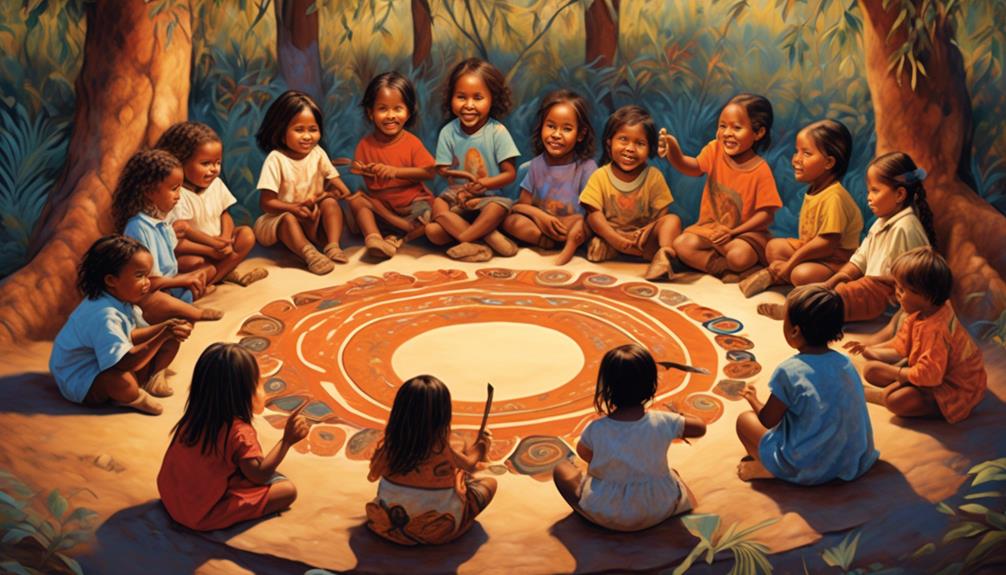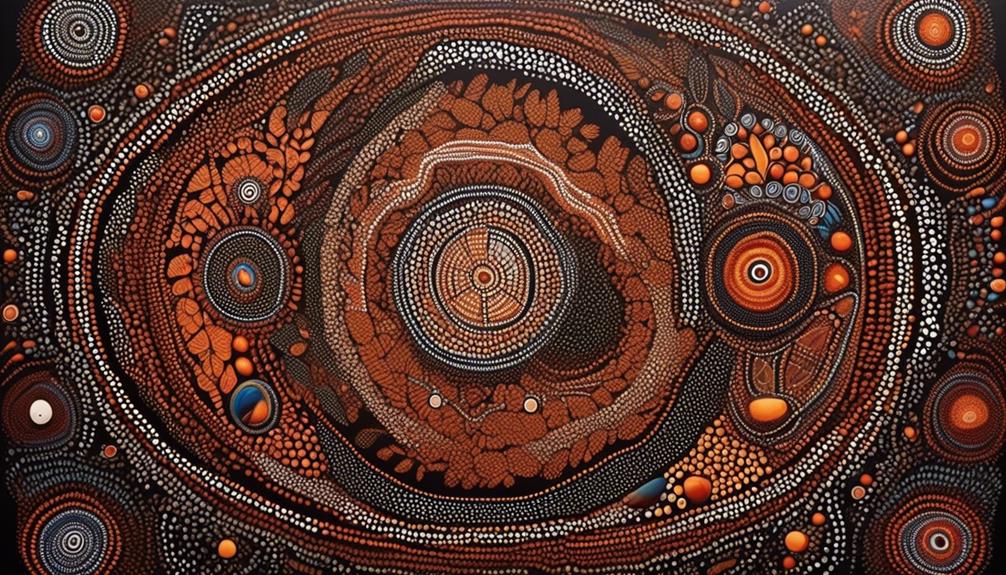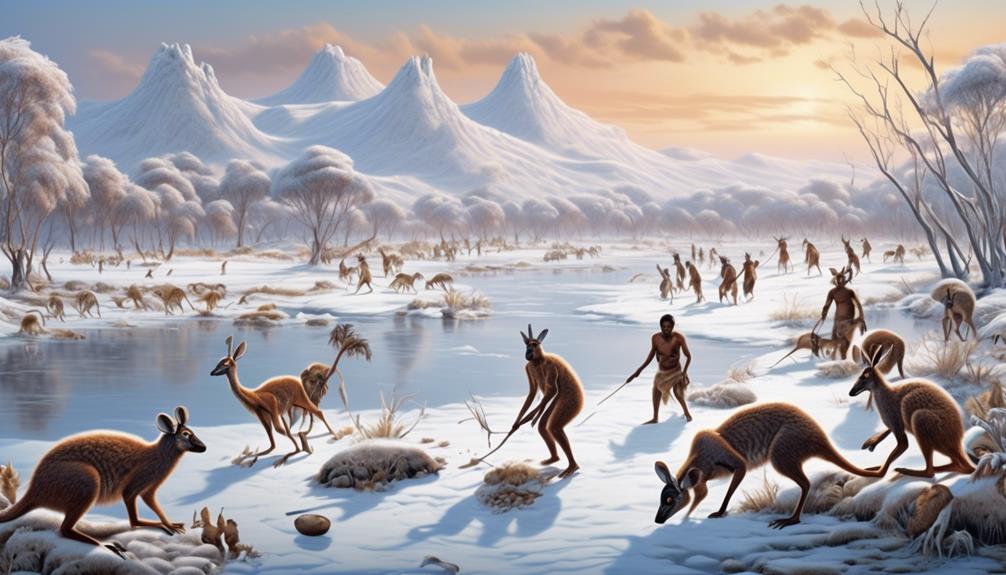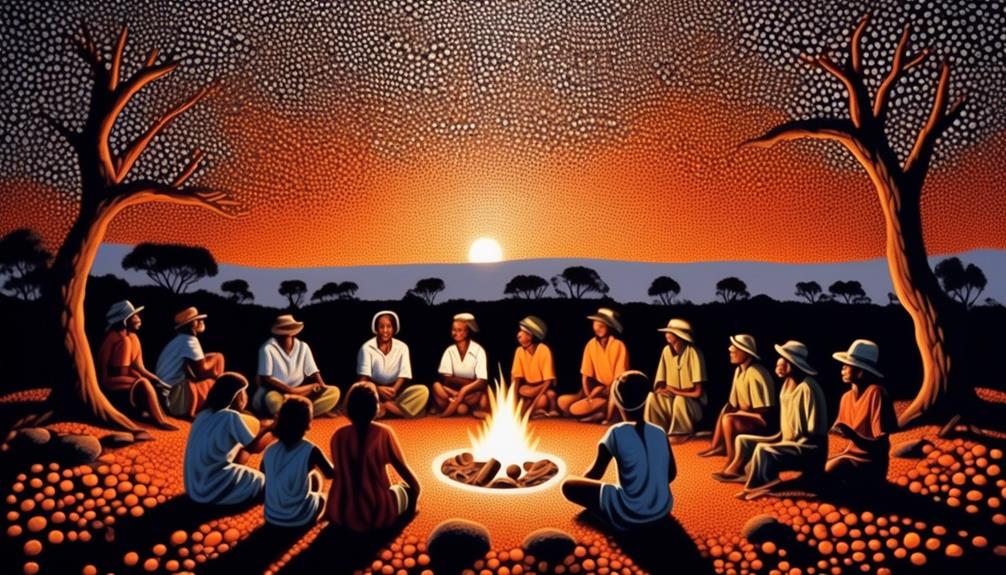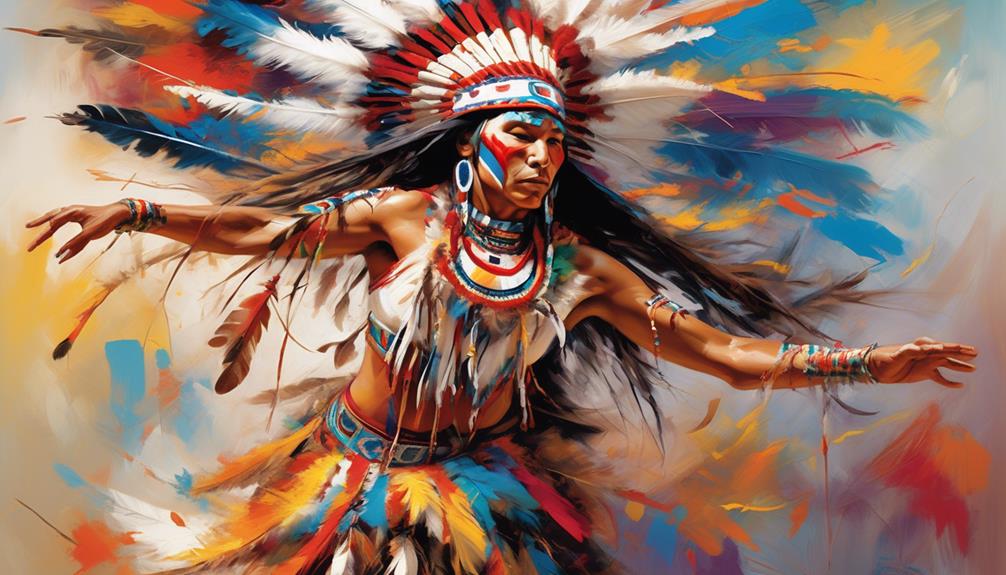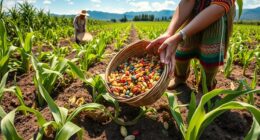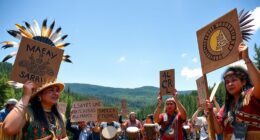Did you know that Aboriginal Australians speak over 250 distinct languages and have a rich cultural heritage?
Introducing preschoolers to Aboriginal ideas and traditions can be both educational and engaging.
If you're looking for unique and meaningful activities to incorporate into your preschool curriculum, exploring Aboriginal concepts could provide a valuable learning experience for young children.
Key Takeaways
- Storytelling and Dreamtime myths are important for preserving and sharing cultural knowledge, and can help preschoolers develop an appreciation for the cultural richness and diversity of Aboriginal peoples.
- Dot painting is a significant form of Aboriginal art that conveys stories and symbols from Indigenous culture, and can be used to teach children about the importance of respecting nature and understanding the interconnectedness of all living things.
- Traditional Aboriginal music offers a rich heritage that preschoolers can engage with through rhythm exploration and the introduction of cultural instruments like the didgeridoo.
- Nature-inspired craft projects and outdoor exploration can deepen children's connection to the environment and foster artistic expression and appreciation for the Earth, while using natural materials connects them to Aboriginal culture's deep connection to nature.
Storytelling and Dreamtime Myths
Discover the enchanting world of Aboriginal storytelling and Dreamtime myths, igniting the imagination of preschoolers with rich cultural heritage and timeless wisdom.
Aboriginal cultures have a strong tradition of passing down knowledge through oral traditions, using storytelling as a way to teach important cultural beliefs and values. These stories aren't just entertaining tales but are also an integral part of preserving and sharing cultural knowledge.
Dreamtime myths, for example, are ancient stories that explain the creation of the world, the significance of natural landmarks, and the behaviors of animals. By introducing preschoolers to these stories, they can develop an appreciation for the cultural richness and diversity of Aboriginal peoples.
Through these stories, children can also learn about the importance of respecting nature, living in harmony with the land, and understanding the interconnectedness of all living things.
Dot Painting Activities
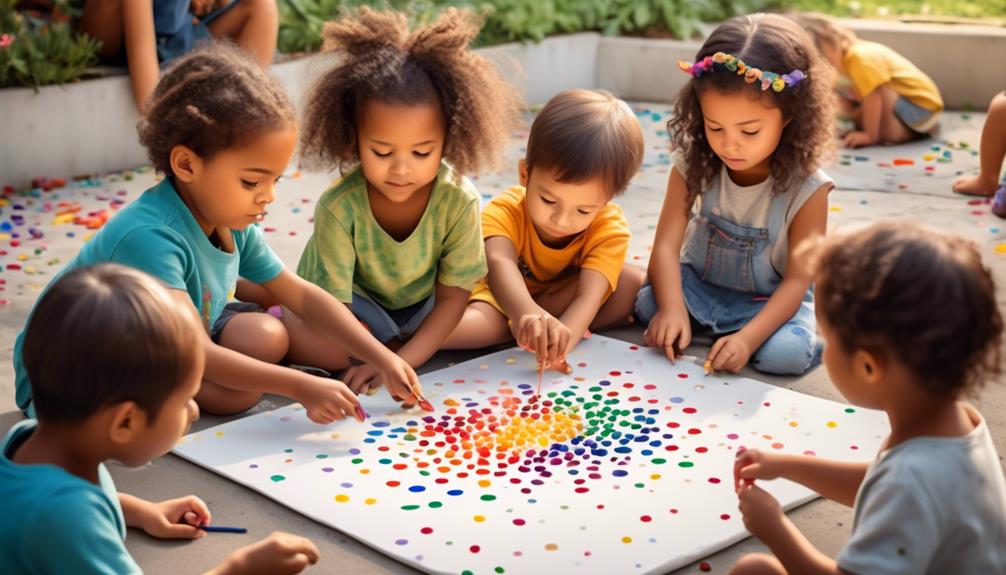
Engage preschoolers in the vibrant world of Aboriginal art and culture through dot painting activities, fostering creativity and appreciation for Indigenous traditions. Dot painting is a significant form of Aboriginal art, often used to convey stories and symbols from Indigenous culture. When teaching dot painting to preschoolers, it's important to introduce the cultural significance of this art form. You can start by explaining that dot painting techniques have been used by Aboriginal people for thousands of years as a way to pass on knowledge, traditions, and beliefs. Encourage children to use their creativity to create their own dot paintings, explaining that each dot can represent an element of a story or a connection to the land. Below is a table that outlines some key dot painting techniques and their cultural significance:
| Dot Painting Technique | Cultural Significance |
|---|---|
| Using different sized dots | Depicting different elements in a story |
| Circular dot patterns | Representing landmarks or campsites |
| Layering dots | Showing depth and texture in the painting |
| Color symbolism | Conveying meanings and emotions through different colors |
Traditional Music Exploration
Explore the rich heritage of traditional Aboriginal music with preschoolers, immersing them in the captivating rhythms and melodies of Indigenous cultures. The exploration of traditional music can provide a wonderful opportunity for children to engage with the rich tapestry of Aboriginal heritage.
Here's how you can introduce preschoolers to the enchanting world of traditional Aboriginal music:
- Rhythm Exploration: Encourage children to feel the beat of the music by clapping their hands, tapping their feet, or using simple percussion instruments like rhythm sticks or drums.
- Cultural Instruments: Introduce children to traditional Aboriginal instruments such as the didgeridoo, clapsticks, or bullroarer. Let them observe, touch, and experience the unique sounds of these instruments.
- Interactive Singing: Engage children in singing traditional Aboriginal songs. Encourage them to join in with simple repetitive phrases or sounds that are characteristic of many Aboriginal songs.
- Dance and Movement: Encourage children to express themselves through movement, incorporating traditional Indigenous dance styles and movements that reflect the stories and rhythms of Aboriginal music.
- Storytelling through Music: Use traditional Aboriginal music as a backdrop for storytelling, allowing children to connect with the cultural significance and meaning behind the music.
Nature-inspired Craft Projects
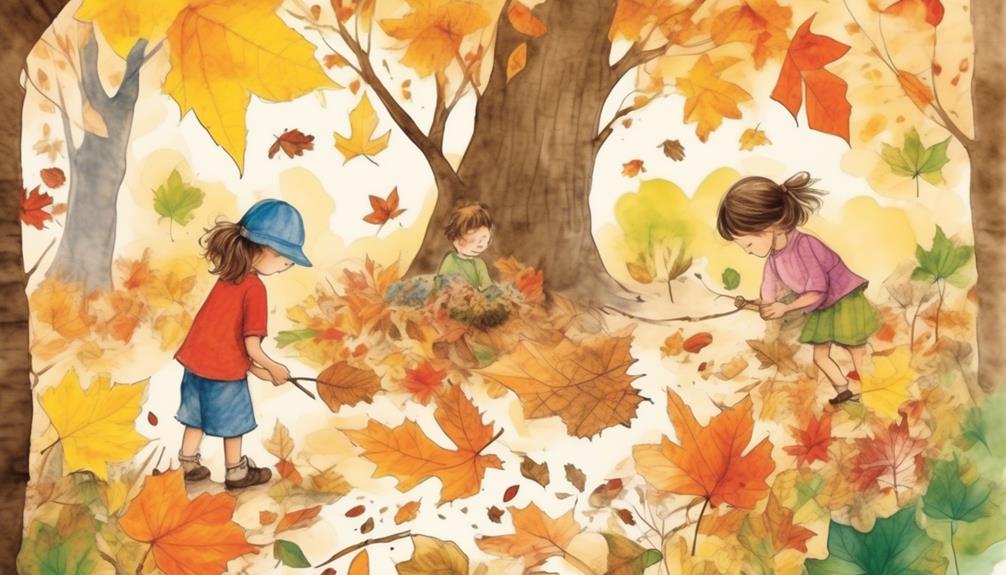
Immerse preschoolers in the wonders of nature and Aboriginal culture by incorporating nature-inspired craft projects that celebrate the beauty of the natural world. Outdoor exploration will ignite their curiosity and deepen their connection to the environment.
Encourage sensory experiences by taking the children on nature walks to collect natural materials like leaves, twigs, and stones. These can then be used in craft projects, allowing the little ones to experience the textures, scents, and colors of the outdoors in a hands-on way.
Engage their creativity by providing opportunities for expressive art using these natural materials. For example, they can create leaf rubbings, paint with mud, or make nature collages. This not only fosters artistic expression but also fosters a greater appreciation for the environment and the resources it provides.
Encouraging children to create art with natural materials instills in them a sense of respect for the Earth and its offerings. Through these activities, preschoolers can learn about Aboriginal culture's deep connection to nature and gain a greater understanding and appreciation for the world around them.
Indigenous Games and Dance
Have you ever wondered about the traditional Indigenous games and dances that have been passed down through generations, providing a rich insight into their culture and values? Cultural traditions are woven into the fabric of Indigenous communities, and these games and dances serve as a vibrant expression of their heritage.
Engaging with these activities not only fosters physical movement but also deepens understanding and appreciation for Indigenous culture. Here are some Indigenous games and dances that you can explore with your preschoolers:
- Mangarayi Dance: This dance from the Mangarayi people involves rhythmic movements and storytelling, offering a beautiful blend of movement and cultural expression.
- Wabun Run: A traditional game played by the Wabanaki people, it involves agility and speed, encouraging children to move and develop physical coordination.
- Yulunga: This Aboriginal game promotes teamwork and coordination, emphasizing the significance of community within Indigenous cultures.
- Corroboree: A ceremonial gathering that includes dance, music, and storytelling, providing a holistic experience of Indigenous traditions.
- Barnbardi: A game of catch and chase played by the Yanyuwa people, promoting physical activity and teamwork.
Engaging with these Indigenous games and dances can be a valuable way to introduce preschoolers to the beauty of Indigenous culture and movement.
Frequently Asked Questions
How Can I Incorporate Aboriginal Language and Words Into My Preschooler's Daily Routine?
To incorporate aboriginal language into your preschooler's daily routine, start by using simple words during activities like eating, playing, or getting ready for bed. This can help them learn and appreciate the language from a young age.
It's important to honor cultural protocols and teach preschoolers about the significance of the words they're learning.
Consistency and enthusiasm are key to integrating aboriginal language into their daily lives.
Are There Any Specific Cultural Protocols or Customs I Should Be Aware of When Teaching Aboriginal Culture to Preschoolers?
When teaching Aboriginal culture to preschoolers, cultural respect is crucial. Be aware of specific protocols and customs, and incorporate them into your teachings.
Use sensory activities to engage children and make the learning experience interactive and memorable. By immersing them in the culture through smell, touch, and taste, you can create a deeper connection.
Emphasize the importance of understanding and respecting Aboriginal traditions, fostering a sense of appreciation and empathy in the children.
What Are Some Ways to Involve Parents and the Wider Community in Teaching Aboriginal Ideas to Preschoolers?
To involve parents and the wider community in teaching Aboriginal ideas to preschoolers, consider hosting cultural events or workshops where families can participate. Encourage parent engagement through activities like storytelling, traditional craft-making, or language immersion sessions.
Foster community involvement by inviting local elders or knowledge keepers to share their wisdom with the children. By creating opportunities for cultural sensitivity and language immersion, you can help parents and the community play an active role in teaching Aboriginal ideas to preschoolers.
How Can I Adapt These Activities for Children With Special Needs or Disabilities?
Adapting activities for children with special needs or disabilities involves creativity and flexibility. Consider incorporating cultural language and traditions into their daily routine to create an inclusive and enriching experience.
What Are Some Age-Appropriate Ways to Discuss the History of Colonization and Its Impact on Aboriginal Communities With Preschoolers?
When discussing the history of colonization and its impact on Aboriginal communities with preschoolers, it's important to have age-appropriate discussions.
You can focus on teaching them about different cultures and the importance of respecting others.
Use storytelling and interactive activities to help them understand the impact on communities.
Conclusion
Incorporate Aboriginal ideas for preschoolers to foster cultural awareness, creativity, and connection to the natural world.
Embrace storytelling, dot painting, traditional music, nature-inspired crafts, and indigenous games and dance.
By embracing these activities, you aren't only providing a fun and engaging learning experience for preschoolers, but also promoting a deeper understanding and appreciation for Aboriginal culture and traditions.
Let's celebrate diversity and inspire young minds to explore the rich and vibrant heritage of Indigenous peoples.
Talise is a talented writer and an expert in her field. Her unique perspective and insights enrich our content with depth and authenticity. With a wealth of knowledge and a strong connection to the subjects she writes about, Talise crafts engaging and informative articles that resonate with our readers. Her dedication to bringing Indigenous culture and wisdom to light is truly commendable.
